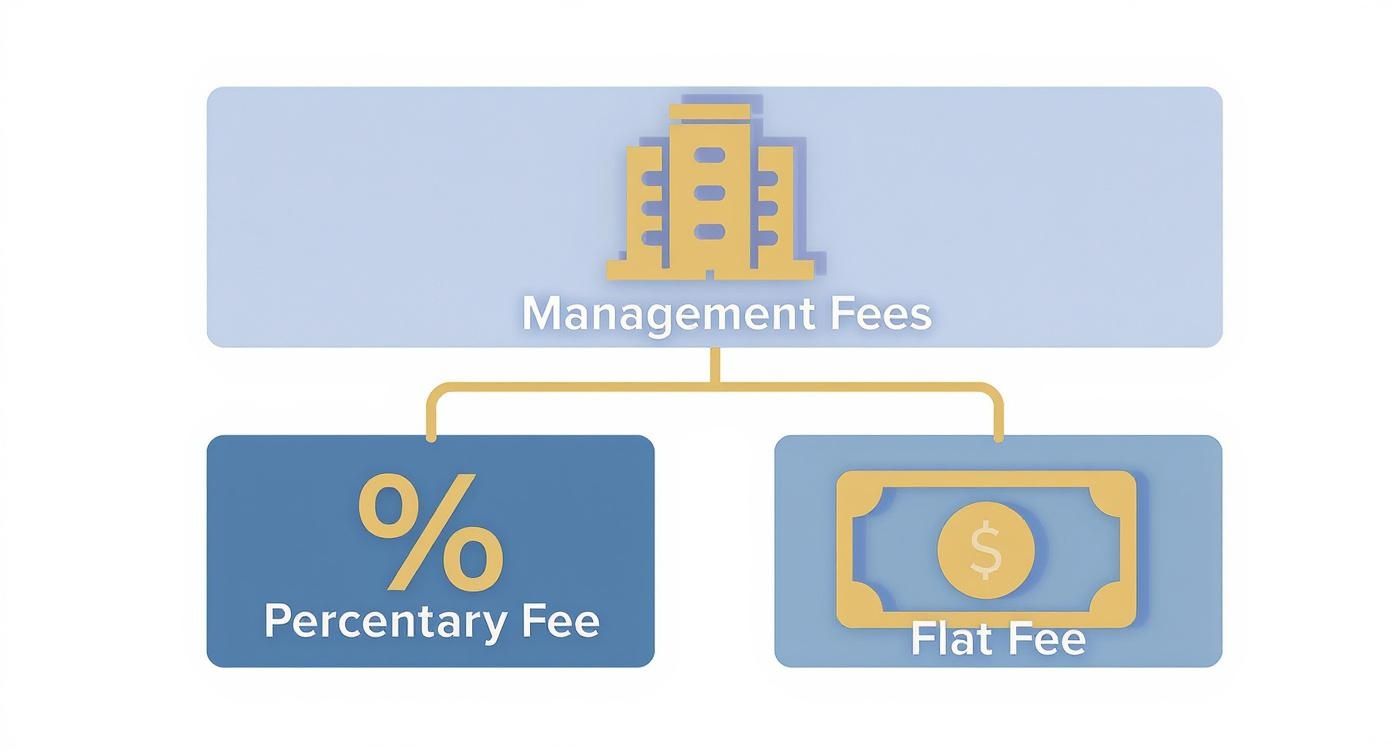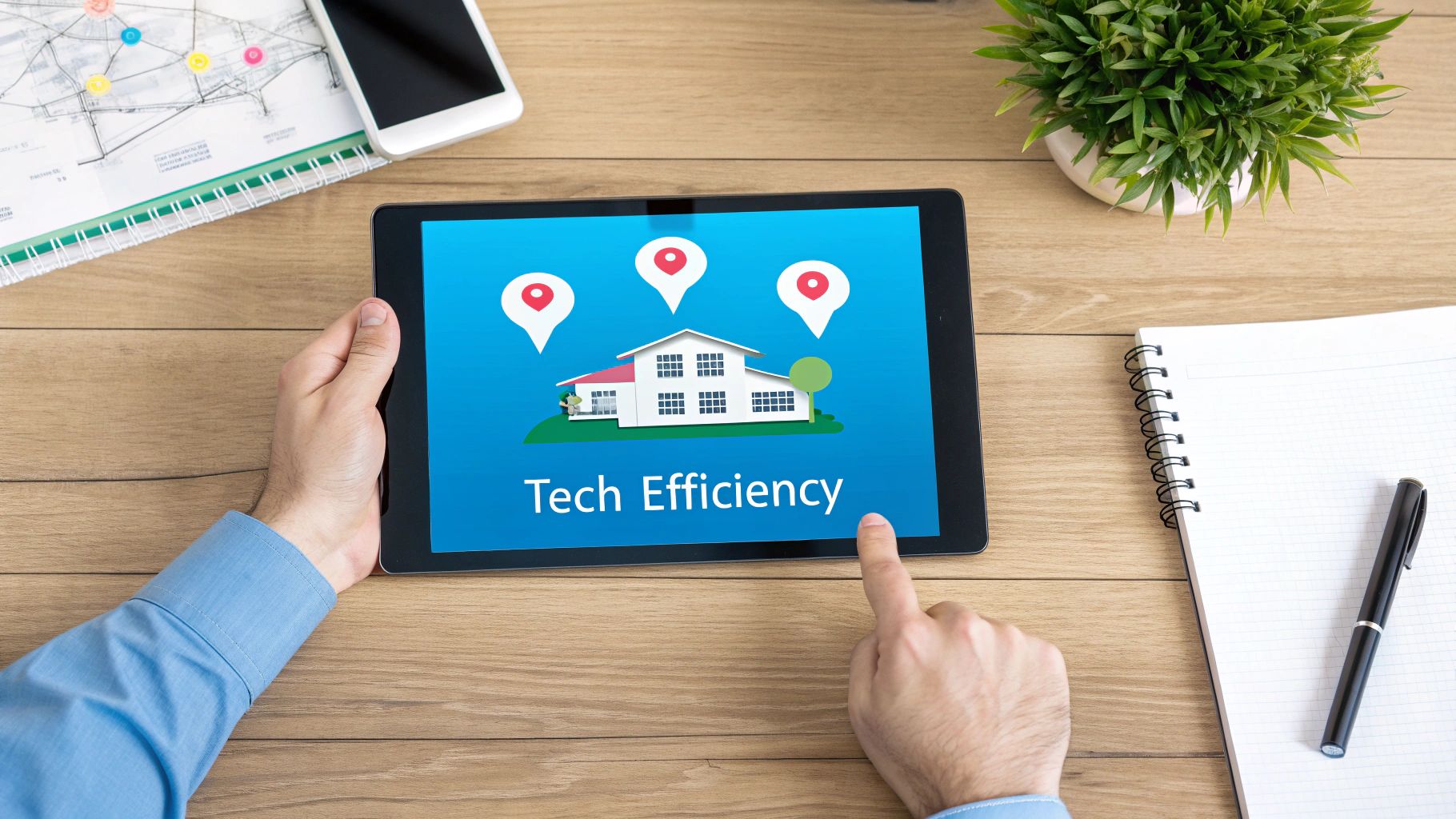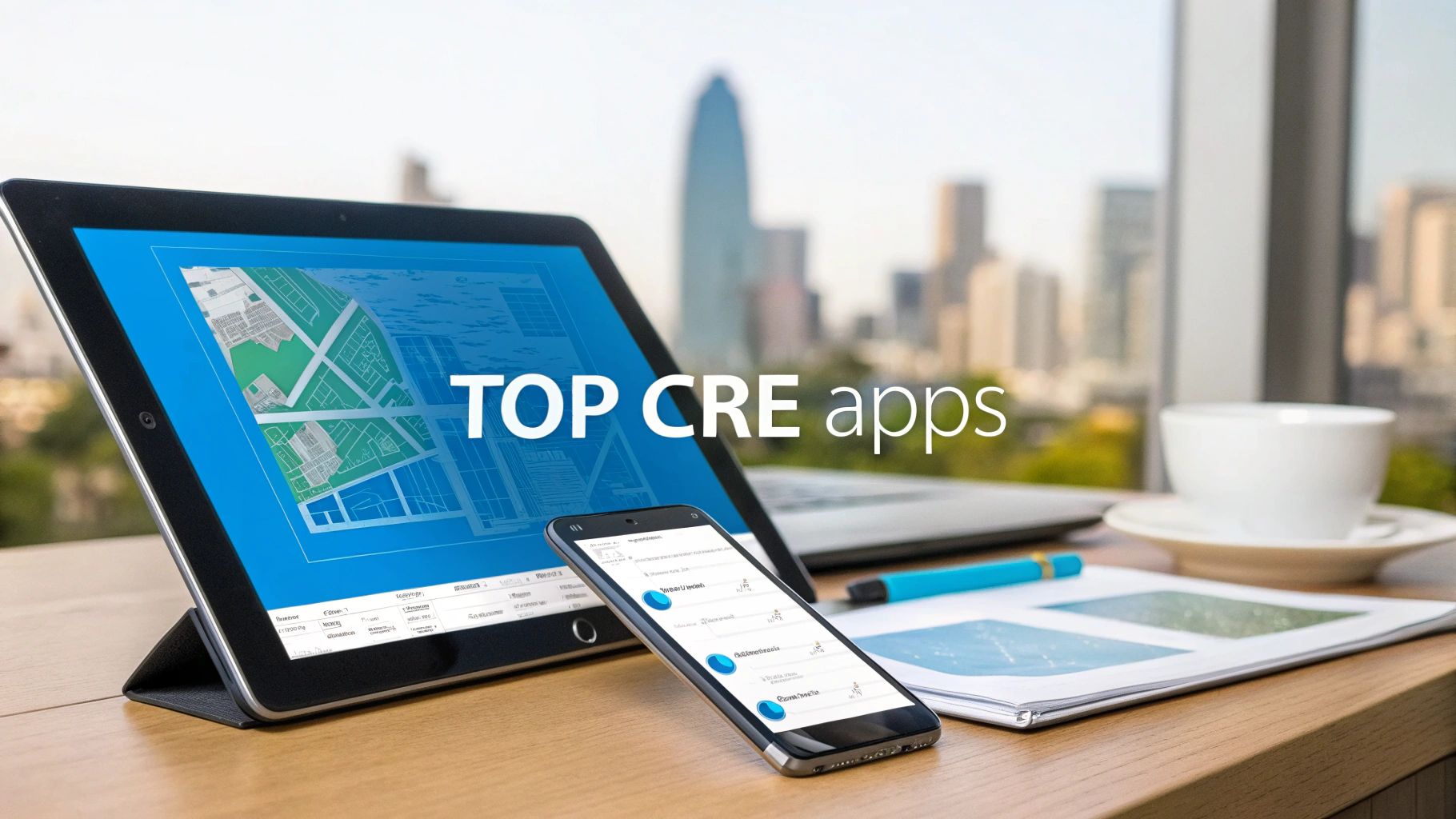When you're operating a portfolio of 1,000+ units, property management costs stop being just another line item. They become a critical operational metric that directly impacts cost per door, net operating income (NOI), and scalability. While industry benchmarks often cite 8% to 12% of monthly rent or a flat per-unit fee, for enterprise-level operators, the real conversation is about ROI.
A single percentage point difference on a 2,000-unit portfolio can easily swing annual expenses by over $200,000. That’s a direct hit to your bottom line. But the right management strategy isn't an expense—it's an investment that drives revenue by optimizing your most critical KPIs: Days on Market (DOM) and lead-to-tour conversion rates.
Deconstructing Management Costs for Large Portfolios
To truly understand your costs, you must look beyond the headline percentage and analyze its impact on your entire operational framework. Before diving into fee models, it's crucial to recognize the comprehensive work involved in managing an investment property—from marketing and tenant screening to coordinating maintenance, handling financials, and ensuring legal compliance. Each task contributes to your cost per door, a metric that must be obsessively tracked and optimized at scale.
For large portfolios, the key isn't just minimizing fees; it's maximizing value. This means partnering with solutions that deliver measurable outcomes.
Shifting Fee Models and Their Impact
Property management fees aren't one-size-fits-all, varying by market, property type, and service scope. For residential portfolios, that 8% to 12% of monthly rent remains the classic model for full-service management. However, for property management companies (PMCs) managing assets in high-rent markets, flat-rate fees of $100 to $300 per unit per month are gaining traction as a more predictable and scalable alternative.
Here’s a quick comparison of the common models for enterprise-scale portfolios.
At-A-Glance Fee Structure Comparison for Portfolios
Ultimately, for enterprise-level operators, the conversation must pivot from cost to ROI. The right management partner or technology platform is a strategic investment that delivers quantifiable returns by:
- Slashing Days on Market (DOM): Every vacant day is lost revenue. Speed-to-lease is the most direct path to boosting NOI.
- Optimizing Your Cost Per Door: Driving down operational overhead through process automation and efficiency gains.
- Improving Lead-to-Tour Conversion: Ensuring qualified leads tour properties immediately, before they move on to a competitor.
This guide will break down cost structures, expose hidden fees that erode profitability, and provide a framework for calculating the ROI that truly matters as you scale your operations from hundreds to thousands of units.
Breaking Down the Core Property Management Fee Structures
Understanding how much property management costs requires a deep dive into the fee structure you choose. Each model has significant financial implications for a large-scale portfolio, affecting everything from budgeting to the alignment of incentives between you and your partners. For operations directors overseeing hundreds or thousands of units, mastering this is fundamental to optimizing your cost per door.
Let's analyze the three main structures and their impact when operating at scale.
The Percentage of Rent Model
This is the traditional approach: a management partner takes a percentage of collected rent, typically 8% to 12%. It’s popular because it aligns incentives—they make more when you make more. For a portfolio with mid-range rental rates, it can be an effective partnership.
However, in high-value markets, this model’s cost can escalate rapidly. Consider a 1,000-unit portfolio with an average monthly rent of $2,000. A 10% fee translates to $200,000 per month, or $2.4 million annually. At this scale, it becomes critical to calculate the breakeven point where a flat-fee model offers superior financial performance.
The Flat-Fee Model
For portfolio managers driven by financial forecasts and predictable P&L statements, the flat-fee model is ideal. You pay a fixed dollar amount per unit each month, usually between $100 and $300. This predictability is a massive advantage when managing cash flow across diverse markets with varying rent prices.
This structure decouples your management expense from rent inflation, ensuring that as your rental income grows, your core management costs remain stable. This predictability is essential for accurate P&L statements and long-term financial planning at an enterprise level.
The infographic below clearly illustrates the difference between these two primary fee structures.

As you can see, the flat-fee model provides a consistent, predictable cost, whereas the percentage-based fee fluctuates directly with rental income.
The Hybrid or À La Carte Model
The hybrid model is the most flexible and modern approach, perfectly suited for tech-forward operators aiming to surgically outsource specific, high-cost functions. For large, distributed portfolios, this is a powerful strategy to boost operational efficiency without the overhead of a full-service contract.
Instead of a bundled package, you pay only for the services you need, such as:
- Leasing and Showings: Outsourcing on-demand agents to handle tours, which can drastically cut down your Days on Market (DOM) and improve lead-to-tour conversion rates.
- Maintenance Coordination: Leveraging a third-party service to manage work orders and vendor communications at scale.
- Tenant Screening: Paying a per-applicant fee for comprehensive background and credit checks.
This model allows you to maintain control over core operations while integrating specialized services to slash fixed overhead. For a prime example of how this applies to leasing, you can review the on-demand pricing for services like Showdigs, which aligns perfectly with this flexible, cost-effective strategy. By unbundling services, you can build a custom management solution that directly targets your most important KPIs.
Uncovering Hidden Costs and Ancillary Fees

The headline management fee is just the starting point. For any large-scale portfolio manager, the true cost of a management partnership is often buried in the contract’s fine print, where ancillary fees can quietly erode your net operating income (NOI).
This is where your financial objectives and a management company's revenue model can diverge. If you’re serious about optimizing your cost per door, mastering the language of these extra charges is non-negotiable.
Common Ancillary Fees to Scrutinize
When reviewing a management agreement, your team must perform a forensic analysis. Seemingly small charges can snowball into massive expenses across a large portfolio.
- Leasing or Tenant Placement Fees: A major cost center. Typically equivalent to one month's rent, this fee is charged for every new tenant. For a 2,000-unit portfolio with a 30% annual turnover, this becomes a significant recurring expense that directly impacts your budget.
- Lease Renewal Fees: Some firms charge a fee—often a flat $200-$500—for renewing an existing tenant’s lease. This fee can disincentivize efforts to retain good tenants, costing you more for what should be a straightforward process.
- Maintenance Markups: A critical area for scrutiny. A seemingly minor 10% markup on vendor invoices can spiral into hundreds of thousands of dollars in excess costs annually across a portfolio of thousands of units.
- Eviction and Legal Fees: While you expect to pay for legal proceedings, some managers add a premium for coordinating the process on top of actual attorney bills. This can range from a flat fee to an hourly rate that inflates costs.
At scale, these "minor" fees are anything but. A poorly negotiated contract can create a huge gap between the management fee you were quoted and your true, all-in cost per door, hitting your portfolio's profitability right where it hurts.
While the base management fee is important, these ancillary charges often reveal the true cost of partnership. The table below breaks down common fees and their multiplied impact on a large portfolio.
Common Additional Fees and Their Portfolio Impact
What appears as a small charge for a single unit can become a major financial drag when multiplied by hundreds or thousands of doors. Diligence is paramount.
A Strategic Checklist for Contract Dissection
To avoid these financial traps, treat every management contract as a strategic document. The goal is to determine the genuine "all-in" cost and ensure your partner’s incentives are aligned with your KPIs, such as low vacancy and high NOI.
Before signing, ensure your operations team can answer these critical questions:
- Is there a hard cap on maintenance markups, and are we allowed to use our own vendors?
- Can we negotiate or eliminate lease renewal fees based on our portfolio size?
- What is the exact process and fee structure for placing new tenants, and is it tied to performance?
- Are routine inspections included in the base fee, or are they billed separately?
- Are there any general administrative fees charged on top of the monthly management rate?
By digging into these details, you're not just negotiating a contract—you're protecting your bottom line and building a partnership architected for scalable, profitable growth.
Key Factors That Influence Management Costs at Scale
Why does a 1,000-unit portfolio in one market cost more to manage than a similar portfolio elsewhere? The answer lies in key variables that dictate operational complexity and, consequently, your management fee. For enterprise operators, understanding these factors is crucial for accurate budgeting and negotiating favorable terms.
First, the physical characteristics of your rental units are a primary cost driver.
- Single-Family Rentals (SFR): A portfolio of geographically dispersed single-family homes inherently carries higher per-door costs. Each property requires individual trips for showings, maintenance, and inspections, making it challenging to achieve economies of scale.
- Multifamily Properties: In contrast, a portfolio of multifamily units—even without on-site staff—allows for greater operational efficiency. A single leasing agent can show multiple units in one visit, and maintenance vendors can address several work orders in one location, driving down travel and labor costs.
Geographic Density and Market Dynamics
The geographic distribution of your portfolio is a major factor in your management costs. Managing 1,000 units concentrated in a single metro area is operationally simpler than managing the same number of units scattered across five states. Denser portfolios allow for optimized routes, centralized vendor relationships, and a more streamlined management structure.
Market dynamics also play a significant role. The global property management market is experiencing rapid growth, currently valued at around $23.03 billion. North America dominates with a 43% revenue share, reflecting intense real estate activity. This growth, particularly in the residential sector, increases competition and influences pricing based on local market pressures and regulations. Analyzing these trends in the property management market helps explain cost variations between regions.
Scope of Services and Technology Integration
The scope of services required is a direct cost factor. A full-service contract covering everything from marketing to evictions will naturally cost more than an à la carte model where you select specific services to outsource. An increasing number of tech-forward firms are unbundling these services to gain tighter control over their expenditures.
Technology is the great equalizer for distributed portfolios. By automating high-touch tasks like tour scheduling and centralizing communications, modern platforms enable firms to reduce overhead for remote management, directly addressing the core challenge of scaling efficiently.
This strategic shift allows you to build a custom operational stack, integrating best-in-class solutions where they are most needed. By adopting smart tech, you can significantly improve property management operations and reduce your all-in cost per door, regardless of geographic dispersion. It’s about replacing manual labor with scalable systems—turning a cost center into a competitive advantage.
Is Property Management an Expense or an Investment? Let's Run the Numbers.
For enterprise operators managing large portfolios, property management is not an expense—it's a strategic investment. The conversation must shift from "How much does it cost?" to "What is my return on investment?"
A sophisticated management strategy generates quantifiable value by directly improving key performance metrics like tenant retention and, most critically, Days on Market (DOM). Every day a unit sits vacant represents a direct revenue loss. This is not a minor issue; it is a financial leak that expands exponentially across a portfolio of thousands of units. The first step in calculating your ROI is to quantify this loss.
The True Cost of a Vacant Day
To grasp the financial stakes, large-scale operators must calculate their portfolio's daily vacancy cost. This isn't a vague estimate; it's a hard dollar amount derived from a simple formula.
The Vacancy Cost Formula is straightforward:
(Total Annual Rent Potential / 365 Days) = Daily Cost of Vacancy
Let's apply this to a hypothetical 1,000-unit portfolio with an average rent of $1,800 per month. The total annual rent potential is $21.6 million. The calculation reveals that every single day of vacancy across your portfolio costs you $59,178.
Quantifying the Return on Shorter Vacancies
Once you know your daily vacancy cost, the ROI from superior management becomes crystal clear. Suppose a strategic investment—whether a new management partner or a technology platform—reduces your average DOM by just one week (7 days). The financial impact is immense.
- 7 Days x $59,178 (Daily Cost) = $414,246 in recaptured revenue
Suddenly, an annual management or software fee of $150,000 or $200,000 is no longer an expense. It's a high-performing investment that delivered a 2x return simply by leasing units faster. This is the financial framework that justifies investing in partners and tools that deliver measurable results.
The property management industry is a vast and competitive landscape, projected to reach $98.88 billion by 2029. With over 304,000 companies in the U.S. alone—many managing portfolios between 101 and 500 units—those who can demonstrate ROI through DOM reduction will win. Savvy operators leverage this competitive market to forge partnerships that deliver clear financial gains. You can explore the scale of the property management sector on Doorloop.com.
Ultimately, analyzing how much property management costs without calculating the potential ROI is like tracking expenses without monitoring revenue—it tells only half the story. The true measure of any management strategy is its ability to convert operational efficiency into tangible portfolio growth.
How Technology Reduces Costs and Boosts Efficiency
For any modern, large-scale property management company, technology is the central nervous system of an efficient portfolio. PropTech is fundamentally rewriting the rules of property management costs, shifting the focus from manual labor to automated, scalable systems that drive down cost per door.

The most immediate impact is on repetitive, time-intensive tasks that drain resources and prolong the leasing cycle. High-volume activities like scheduling tours, qualifying leads, and responding to common inquiries can be automated, significantly reducing payroll costs and minimizing human error. This automation enables the management of geographically dispersed portfolios from a centralized hub, providing operations directors with real-time data and control without needing on-site staff at every location.
Optimizing High-Cost Operational Areas
The leasing process, particularly property showings, is a major source of operational costs. Every hour your team spends coordinating tours is a direct labor expense. Every qualified prospect who cannot secure a timely showing is a lost revenue opportunity. This is where specialized platforms become indispensable. They are purpose-built to address these high-cost areas and directly improve critical metrics like lead-to-tour conversion rates and Days on Market (DOM).
For example, implementing a system that allows a qualified prospect to schedule their own showing—often for the same day—can reduce your leasing timeline by days or even weeks. Securing a lease faster directly increases revenue and establishes a repeatable, scalable process that lowers your all-in cost per door.
For enterprise-level portfolios, technology isn't just about saving a few bucks on small tasks. It's about building an operational machine that can grow from 1,000 to 10,000 units without your headcount or overhead exploding alongside it.
By integrating smart automation, property managers can transform their cost structure from a heavy, fixed expense into a lean, dynamic operation. To see how this is being implemented today, explore some of the best AI-powered property management tools available. These systems don't just reduce what property management costs; they fundamentally change how you create value across your entire portfolio.
Got Questions? We've Got Answers
Navigating property management costs for a large-scale operation can be complex. Here are concise answers to common questions from operators managing large portfolios.
Is a Flat-Fee or Percentage-Based Model Better for a Portfolio Over 1,000 Units?
The optimal choice depends on your portfolio's average rent and strategic goals. A percentage fee aligns your manager's incentives with rent growth. However, in high-rent markets, this model can become excessively expensive.
A flat fee offers predictability, a crucial advantage for large-scale financial planning. Many enterprise clients adopt a custom hybrid model: a lower base fee combined with performance bonuses tied to critical KPIs like vacancy reduction and renewal rates.
How Can I Accurately Budget for Management Costs Across Multiple Markets?
Budgeting across different markets requires a data-driven approach. First, determine your true "all-in" cost per door by auditing existing management contracts to identify every fee.
Next, create market-specific adjustments based on local rent averages, labor costs, and regulatory complexity. A property in a highly regulated city will have higher compliance costs.
The most effective method is to use a centralized management platform to track expenses in real-time. This provides a clear view of performance against budget, allowing you to make proactive adjustments and prevent market-specific issues from derailing your overall financial plan.
What Is the Best Way to Negotiate Fees for a Large Portfolio?
Your scale is your greatest negotiating asset. Enter discussions with hard data on your portfolio's performance: average rent, historical vacancy rates, and tenant quality metrics. You are not just another client; you are offering a significant, stable book of business.
Propose a tiered fee structure where the management percentage decreases as your portfolio grows. This creates a win-win partnership.
Finally, focus on ancillary charges. Maintenance markups and leasing fees can accumulate rapidly across thousands of units. Negotiate hard for caps on these charges. You are offering a long-term, high-volume partnership, and your fee structure should reflect that value.
Ready to slash your Days on Market and optimize your leasing operations at scale? Showdigs provides the AI-backed automation and on-demand agent network designed for large, distributed portfolios. Discover how our platform can transform your cost per door today.






